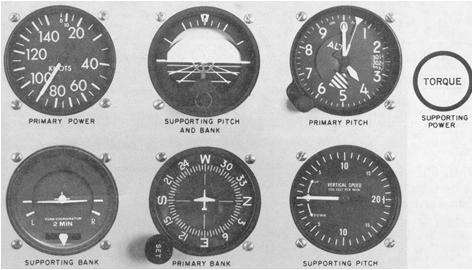
1. Failure to maintain altitude.
2. Failure to maintain heading.
3. Overcontrolling pitch and bank during corrections.
4. Failure to maintain proper pedal trim.
5. Failure to cross-check all available instruments.
Power Control. Establishing specific power settings is accomplished through collective pitch adjustments-RPM is controlled automatically in a turbine engine helicopter. Once a desired power setting is established, frequent attention to the torque meter is necessary. At any given airspeed, a specific power setting determines whether the helicopter is in level flight, in a climb, or in a descent. For example, cruising airspeed maintained with cruising power will result in level flight. If you increase the power setting and hold the airspeed constant, the helicopter will climb. Conversely, if you decrease power and hold the airspeed constant, the helicopter will descend. As a rule of thumb, in a turbine engine helicopter a 10 percent change in the torque value required to maintain level fright will result in a climb or descent of approximately 500 feet per minute, if the airspeed remains the same.
If the altitude is held constant, power determines the airspeed. For example, at a constant altitude, cruising power results in cruising airspeed. Any deviation from the cruising power setting results in a change of airspeed. When power is added to increase airspeed, the nose of the helicopter pitches up and yaws to the right; when power is reduced to decrease airspeed, the nose pitches down and yaws to the left. The yawing effect is most pronounced in single-rotor helicopters, and is absent in helicopters with counter rotating rotors. To counteract the yawing tendency of the helicopter, apply pedal trim during power changes.
To maintain a constant altitude and airspeed in level flight, coordinate pitch attitude and power control. The relationship between altitude and airspeed determines the need for a change in power and/or pitch attitude. If the altitude is constant and the airspeed is high or low, change the power to obtain the desired airspeed. During the change in power, make an accurate interpretation of the altimeter; then counteract any deviation from the desired altitude by an appropriate change of pitch attitude. If the altitude is low and the airspeed is high, or vice versa, a change in pitch attitude alone may return the helicopter to the proper altitude and airspeed. If both airspeed and altitude are low, or if both are high, a change in both power and pitch attitude is necessary.
To make power control easy when changing airspeed, it is necessary to know the approximate power settings for the various airspeeds which will be flown. When the airspeed is to be changed any appreciable amount, adjust the power so that the torque is approximately 5 percent over or under that setting necessary to maintain the new airspeed. As the power approaches the desired setting, include the torque meter in the cross-check to determine when the proper adjustment has been accomplished. As the airspeed is changing, adjust the pitch attitude to maintain a constant altitude. A constant heading should be maintained throughout the change. As the desired airspeed is approached, adjust power to the new cruising power setting and further adjust pitch attitude to maintain altitude. Overpowering and underpowering torque approximately 5 percent is the normal procedure. This results in a change of airspeed at a moderate rate, which allows ample time to adjust pitch and bank smoothly. The instrument indications for straight-and-level flight at normal cruise, and during the transition from normal cruise to slow cruise, are illustrated in Figures 6-6 and 6-7. After the airspeed has stabilized at slow cruise, the attitude indicator will show an approximate level pitch attitude.
The altimeter is the primary pitch instrument during level flight, whether flying at a constant airspeed, or during a change in airspeed. Altitude should not change during airspeed transitions. The heading indicator remains the primary bank instrument. Whenever the airspeed is changed any appreciable amount, the torque meter is momentarily the primary instrument for power control, and it should be adjusted to indicate an exact power setting. When the airspeed approaches that desired, the airspeed indicator again becomes the primary instrument for power control.
Figure 6-6. Straight-and-level flight (normal cruising airspeed).
 |
Figure 6-7. Straight-and-level flight (airspeed decreasing).
 |
The cross-check of the pitch and the bank instruments to produce straight-and-level flight should be combined with the power control instruments. With a constant power setting, a normal cross-check should be satisfactory. When changing power, however, the speed of the cross-check must be increased to cover the pitch and bank instruments adequately. This is necessary to counteract any deviations immediately.
Common Errors During Airspeed Changes.
1. Improper use of power.
2. Overcontrolling pitch attitude.
3. Failure to maintain heading.
4. Failure to maintain attitude.
5. Improper pedal trim.